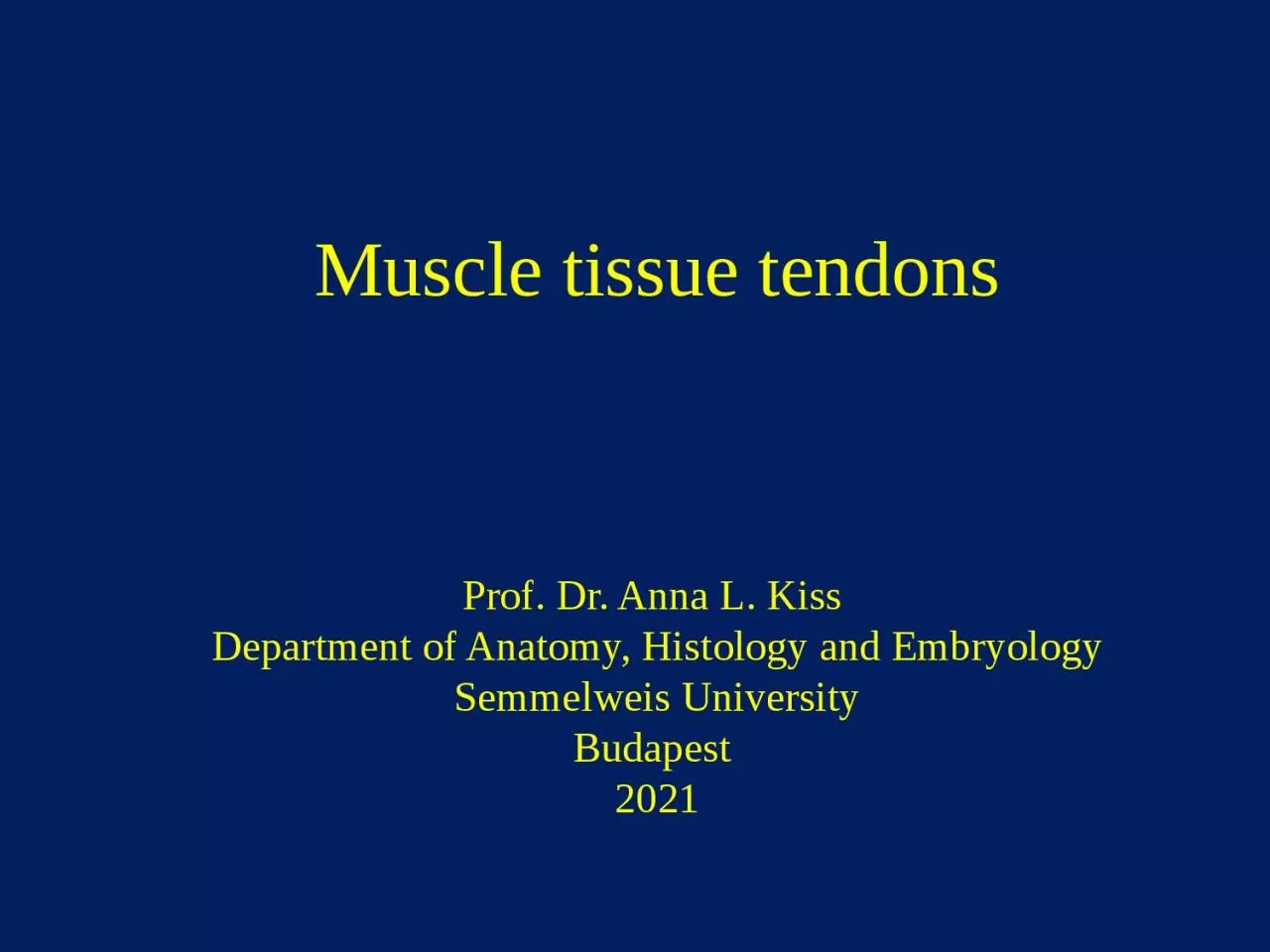

Prof Dr Anna L Kiss Department of Anatomy Histology and Embryology Semmelweis University Budapest 2021 Muscle tissue Function contraction Origin mesoderm Structure ID: 1014693
Download Presentation The PPT/PDF document "Muscle tissue tendons" is the property of its rightful owner. Permission is granted to download and print the materials on this web site for personal, non-commercial use only, and to display it on your personal computer provided you do not modify the materials and that you retain all copyright notices contained in the materials. By downloading content from our website, you accept the terms of this agreement.
1. Muscle tissue tendonsProf. Dr. Anna L. Kiss Department of Anatomy, Histology and EmbryologySemmelweis UniversityBudapest 2021
2. Muscle tissueFunction: contractionOrigin: mesodermStructure: cells or „fibers”
3. Types of the muscle tissueSmooth muscleStiated muscle: skeletal visceral cardiac
4. Smooth muscle evolutionary the most ancient type spindle shaped cells slow, non-synchronized, unvoluntary contraction actin and myosin are NOT arranged in registers internal organs wall
5. Smooth musclenucleus: in the middle of the cells
6. Contraction of smooth muscleContractile proteins: actin and myosinthick filaments: myosinthin filaments: actindense bodies: to help the contraction
7. Smooth muscle contractionFor the contraction: Ca ion: taken up by caveolaeCa-binding protein: calmodulinContractile protein: actin+myosinATP (mitochondria)
8. Striated(skeletal) muscle
9. Stiated (skeletal muscle)Muscle „fibers”: multinucleated giant cells
10.
11. Skeletal musclemyosin: think, anisotropic: A bandactin: thin, isotropic, I bind
12. Structural and functional unit of the striated muscle: sarcomeraMuscle fibersmyofilaments: contractile proteins: actin and myosin: partly overlapping regularly arranged cross striation
13. Electron Microscopic pictureSarcomere: functional unit
14. Sarcomere during contractionZ line: actin binding protein (filamin)
15. Skeletal muscle
16. Contractile proteinsthin filaments thick filaments Myosin head: actin binding site + ATP binding
17. Sarcomere
18. mysosine headmysosine binding site
19. Ca ion binds to troponinconformation is changingtropomyosin „moves” downthe myosin binding site of actin in becoming avalablewhen myosin binds to actin becomes ATP-ase splits the ATP contraction
20. Impulse transmission
21. For the contraction of the skeletal muscle:contractile proteins: actin and myosinCa2+ (stored in sER)impulse transfer from the sarcoplasm to sER-re (triads)ATP (directly from kreatin phosphate, 20 mmól/kg)mitochondriaoxygen (myoglobin + haemoglobin)aerob (biological oxidation)anaerob (fermentation)glycogen: skeletal muscle is the second biggest glycogen store
22. Cardiac muscle
23. Cardiac muscle cells (bifurcation; X or Y shaped branching cells) cross striation: actin and myosin are in register nucleus is in the middle of the cells intercalated disc (Eberth’s line – junctions) lots of capillaries many mitochondria lipofuscin by aging fast, unvoluntary contraction (fast impulse transmission)
24. Cardiac muscleIntercalated disc:special junctions between cellsfast impulse cinduction
25. Intercalated disc (Eberth’s line) fascia adherensdesmosomagap junction (nexus)
26. Cardiac muscleGap junction:ion channel; fast ion flow, fast impulse transmission
27. diad: transverse tubule (from the plasma membrane+sER cistern) large amount of mitochondriaFine structure of the cardiac muscle
28. impulse conducting cells: Purkinje cellsnon-differentiated muscle cells!!
29. General myologyMusculature: active component of the movementStructure: striated muscle (skeletal) tendons: dense regular connective tissue connective tissue sheath: fascia (epimysium)
30. bellytendonproximal end: origindistal end: insertion
31. Structure of the tendontendon sheatha.) outer, fibrous layerb.) inner, synovial layermesotendon
32. ReferencesRöhlich Pál: Szövettan. Budapest, 1999 A szövettani képek a Humánmorfológiai és Fejlődésbiológiai Intézet gyűjteményéből származnak.Carola R, Harley JP, Noback CR: Human Anatomy & Physiology, McGraw-Hill Inc., USA, 1990 Wikipaedia